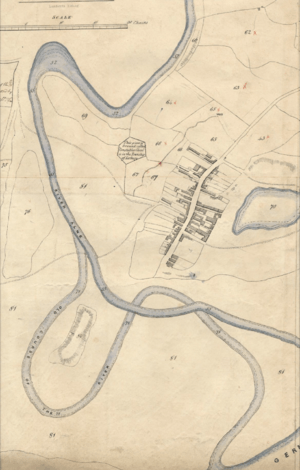Alnmouth Saltmarsh and Dunes facts for kids
| Site of Special Scientific Interest | |
| Area of Search | Northumberland |
|---|---|
| Coordinates | 55°22′47″N 1°36′23″W / 55.37986°N 1.606356°W |
| Interest | Biological |
| Area | 108.4 hectares (270 acres) |
| Notification | 1988 |
| Location map | DEFRA MAGIC map |
Alnmouth Saltmarsh and Dunes is a special place in Northumberland, England. It's called a Site of Special Scientific Interest (SSSI) because it's very important for nature. This area has the biggest saltflat on the north-east coast. It's found on the south side of the River Aln where it meets the sea. What makes it extra special is the amazing variety of plants that grow where the salty marsh meets the sand dunes. This SSSI is also part of an even bigger protected area called the Northumberland Shore SSSI.
Where is Alnmouth Saltmarsh and Dunes?
This special natural area is located in the north-east of England. It's right by Alnmouth, a small village where the River Aln flows into the North Sea. The site covers the south side of the river's mouth. It stretches south along the coast for about 1.5 miles (2.4 km) towards Buston Links. Another SSSI, Warkworth Dunes and Saltmarsh SSSI, is just south of this area. Both are part of the larger Northumberland Shore SSSI. The whole site is about 108.4 hectares (268 acres) big. It includes the salty marshland near the river and a line of sand dunes that go south from the river mouth.
How the Saltmarsh Formed
The saltmarsh at Alnmouth exists because the River Aln changed its path a long time ago. This happened in 1806. Before that year, the river flowed differently. It went around Church Hill, which is at the north-west end of a big sandbank. The river made a big loop, like an oxbow, before flowing into the sea.
But on Christmas Day in 1806, a huge storm hit. The storm was so strong that it made the river break through the northern part of the sandbank. This made the river take its current, straighter path to the sea. When the river changed course, it cut off the old loop. This also sadly destroyed the old Church of St. Waleric, which stood on the sandbank. The old river path then slowly filled up with silt and mud. This is how much of the saltmarsh we see today was created!
Amazing Plants and Animals
The saltmarsh at Alnmouth is a fantastic place for many different plants and animals. No animals graze here, which helps the plants grow freely.
Saltmarsh Plants
- The marsh is mostly covered by a plant called sea-purslane (Halimione portulacoides).
- You can also find some rare seaweeds here, like Bostrychia scorpioides, Fucus vesiculosus, and Pelvetia canaliculata. These are the most northern groups of these seaweeds in Britain!
- Higher up in the marsh, you'll see plants like thrift (Armeria maritima), common saltmarsh-grass (Puccinellia maritima), sea-plantain (Plantago maritima), and sea aster (Aster tripolium). They all grow alongside the sea-purslane.
- Much of the muddy areas that are covered by water at high tide have been taken over by common cord-grass (Spartina anglica).
- In areas that are still open, and in the small channels of the saltmarsh, many birds come to feed and rest. These include gulls, dunlin, and other wading birds like redshank, curlew, and snipe.
Freshwater Area Plants
Near where freshwater flows into the marsh, you can find different plants:
- Common reed (Phragmites australis) grows here.
- There are also three types of plants that are rare in this local area: sea rush (Juncus maritimus), parsley water-dropwort (Oenanthe lachenalii), and slender spike-rush (Eleocharis uniglumis).
Dune and Marsh Edge Plants
The area where the saltmarsh meets the sand dunes is a special habitat. Here you can find:
- Reflexed saltmarsh grass (Puccinellia distans)
- Hard-grass (Parapholis strigosa)
- Sea-milkwort (Glaux maritima)
- The sand dunes themselves have marram (Ammophila arenaria), which helps hold the sand in place.
- Other plants on the dunes include lesser meadow-rue (Thalictrum minus), bloody crane's-bill (Geranium sanguineum), and hound's-tongue (Cynoglossum officinale).
- On the lower slopes of the dunes, you might see bracken (Pteridium aquilinum).
- Some areas have shorter grass, where you can find pretty flowers like cowslip (Primula veris), early-purple orchid (Orchis mascula), violets (Viola spp.), and yarrow (Achillea millefolium).
- Other common plants in these grassy areas are early forget-me-not (Myosotis ramosissima), common cornsalad (Valerianella locusta), hairy tare (Vicia hirsuta), and crosswort (Galium cruciata).
Gravel Area Plants
There's also a unique area of gravel. This gravel was exposed a long time ago when sand was removed from the site. Special plants grow here, including:
- Wild thyme (Thymus praecox)
- Common stork's-bill (Erodium cicutarium)
- Mouse-ear hawkweed (Hieracium pilosella)
- Common centaury (Centaurium erythraea)
- Common bird's-foot trefoil (Lotus corniculatus)
- Common restharrow (Ononis repens)
- Blue fleabane (Erigeron acer)
- Crested hair-grass (Koeleria macrantha)
- Fern-grass (Desmazeria rigida)
- Around the edges of this gravel area, you can find viper's-bugloss (Echium vulgare) and more bloody crane's-bill.
How the Site is Managed
This special area is divided into four parts for management. This helps make sure each part is looked after properly. In 2007 and 2009, experts checked all four parts. They found that the condition of the entire site was "favourable," which means it's healthy and well-cared for.
Who Owns the Land?
The land at Alnmouth Saltmarsh and Dunes is owned by Northumberland Estates. This is the company that manages the land for Ralph Percy, 12th Duke of Northumberland. The land is then leased, or rented, to the National Trust. The National Trust is a charity that helps protect special places in England, Wales, and Northern Ireland.


